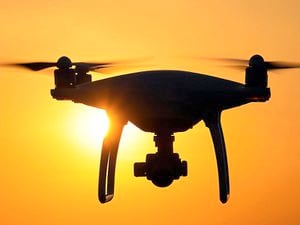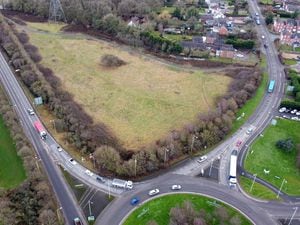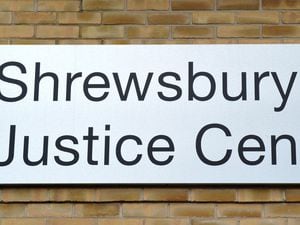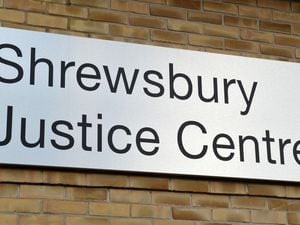Drones crimes soar in Shropshire but no-one convicted
Three crimes involving drones have been reported per week in the police area covering Shropshire, new figures released today reveal.

A total of 36 incidents were reported in the first three months of this year.
The crimes range from attempts to bring items into a prison using drones, flying over airfields or properties and drones being stolen from shops.
But despite the number of reports, there have been no criminal convictions, with the most severe punishment being a community resolution for one of the thefts.
According to the figures, released this month following a Freedom of Information request to West Mercia Police, there have been two instances where drones have been used to convey items into a prison, and one conspiracy to do so.
There have also been five instances of a drone flying near to or about to fly to a prison
The most common crime has been drones spotted flying over properties, which has been reported seven times.
The community resolution punishment is an alternative way of dealing with crimes that can be handed down directly from officers.
Police are urging drone users to make sure they know the rules for their use, as those who don't follow regulations can face criminal convictions.
The warning comes after another near miss was reported involving a drone earlier this week. A drone was seen flying dangerously close to a helicopter just outside Newport on Monday.
Officers were called to the area between Donnington, Edgmond and Newport shortly after 10.30am after a helicopter pilot reported encountering a drone in their flightpath.
PC Lee Thomas from the Newport Safer Neighbourhood Team said “The helicopter pilot advised police that they were flying at an altitude of 1,500 feet when the drone appeared in front of them a very short distance away.
“The maximum height that a drone can be flown at in the UK according to CAA rules is 400 feet and clearly, the consequences of what may have happened should the drone have been sucked into the helicopters engines or such like could have been extremely serious.
“Thankfully on this occasion, the pilot was fortunate enough to see the drone in time and adjust their course to prevent a potential collision."
Officers searched the area around where the incident had taken place but were unable to locate the drone or its owner. Investigations are still ongoing.
In February a helicopter from RAF Shawbury came within 100 feet of a six-foot drone that was being flown 600 feet above the ground near the base.
The drone, which was fitted with a camera, was reported by the pilot over the radio to air traffic control. Both the RAF police and West Mercia Police were informed, and were sent out to investigate.
There have been at least six reports of drones causing a potential risk to aircraft associated with the airbase over the last 12 months, including in places such as Telford and Nesscliffe.
The use of drones, or unmanned aerial vehicles to give them their proper name, is governed by rules issued by the Civil Aviation Authority.
For personal use, no licence is required but operators must stick to a number of rules to ensure they comply with the law.
Drones must not be flown within 50 metres of any person or property, nor within 150 metres of crowds or a built up area.
Operators must make sure they have their drone in sight at all times and that they stay well away from other aircraft or airfields.
People who see a drone breaking these rules in Shropshire should call police on 101.
More information regarding the safe and legal use of drones in the UK can be found on the dedicated CAA website at dronesafe.uk
Drones: Useful but fraught with danger
They have transformed photography, created a new world in film and have been used by police and the military to help in intelligence gathering and fighting crime.
Drones are also being pioneered by agricultural experts at Shropshire’s Harper Adams University to improve efficiency in agriculture.
But they can also be a menace and a danger and their increased popularity as toys has created a challenge.
It isn’t just the UK where authorities are concerned about the use of drones.
In America, Donald Trump wants to give police the power to shoot them out of the sky.
The Trump administration wants Congress to let law enforcement crack down on drones, according to a document leaked this week.
The proposal would let government agencies monitor any unpiloted aircraft system flying over an American “covered facility, location, or installation”. They would be given wide latitude to intercept wireless signals going to the drone, and if they determine that it’s a threat, they’d be able to redirect, disable, confiscate, or destroy it.
“Covered” areas could refer to the sites of search and rescue operations, wildfires, police investigations, and many other government activities. Agencies would set more specific regulations and procedures, which are supposed to “appropriately protect” privacy and civil liberties.
The draft legislation would create an exception for drones in US hacking and surveillance laws, as well as FAA aircraft regulations. Currently, intercepting UAS signals could count as wiretapping or accessing a “protected computer.” Destroying or disabling a drone, meanwhile, could count as aircraft sabotage under FAA rules. The draft states that these rules were created when drones were “unforeseen,” and if passed, the law would supersede them.
Authorities in America see drones as a terror threat.
The issue is also one on the radar of forces in the UK, especially in the light of recent tragic events. Next week’s Uefa Champions League Final in Cardiff may take place under a closed roof after concerns were raised that the event could become a target for a drone attack.





